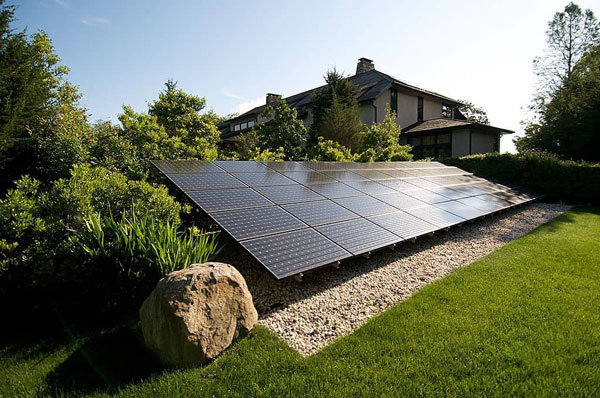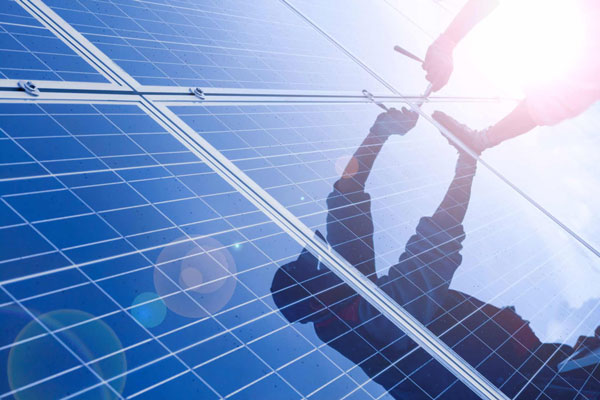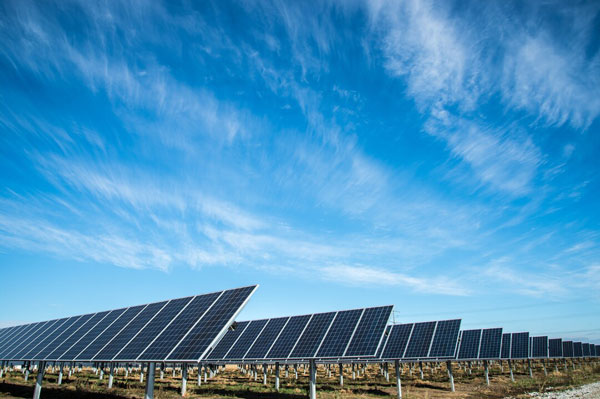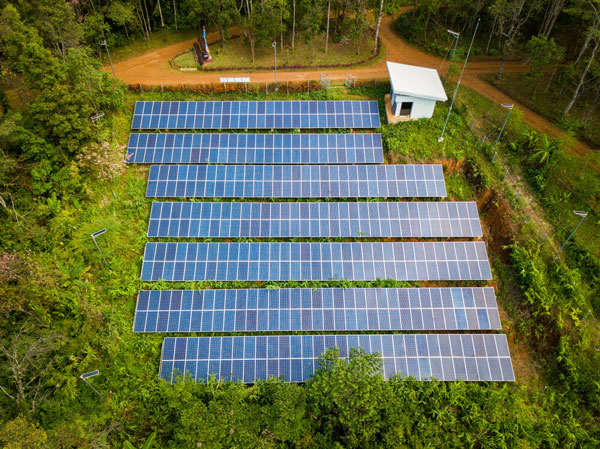Keep clean, ensure proper installation, monitor performance, protect from extreme weather, and schedule regular professional inspections to effectively extend the life of solar panels

Regular Cleaning and Maintenance
Solar panels require regular cleaning and maintenance to reach their max efficiency and life expectancy. Cleaning the average 5kW solar PV system could increase output by up to 20%. Here’s how you can do it:
Why Need to Keep Solar Panels Clean
Your solar panels are likely to get dirty due to dust, dirt, leaves, and even bird droppings. This is a problem as accumulated debris blocks sunlight and lowers the efficiency of your solar array. In turn, a well-maintained system can yield up to 20% more electricity than a dirty one.
Best Ways of Cleaning Solar Panels
Use a Soft Brush and Some Mild Soap: You can also use some warm water to make the soapy solution, but remember to avoid abrasive materials that can scratch your panels. Soft brushes and cloths are the best tools to use.
Rinse Clean: Spray off the soap with a garden hose but remember not to use pressure washers as they tend to damage solar panels.
Safety First: Whenever possible, always clean your solar panels from the ground. Take all necessary safety precautions if you need to climb onto your roof to clean your solar panels.
How Often Should Clean Solar Panels
How often you need to clean your solar panels will depend on your area. Dusty areas may require you to clean your panels at least once every couple of months, while those with less dust may get by with just one or two cleanings a year. However, you should still monitor the cleanliness of your panels and clean them whenever you think they might benefit from it.
Do-It-Yourself Maintenance
However, not all maintenance needs to be done by professionals. For instance, you can clean your solar panels at home to save money. Don’t forget, though, that it’s always better to rely on trained professionals once per year so they can spot any issues that you may miss like loose connections, shading issues, damage to your roof, etc. With professional care, your solar panels can last up to five years longer. Always clean the panels in the early morning or late afternoon to avoid the risk of thermal shock. Plus, use the cleaning time as an opportunity to inspect your solar panels for any visible signs of damage like cracks or discoloration. Finally, remember never to stand on or apply additional weight to your solar panels as that can cause them to crack.

Install Correctly
It is not surprising that you should install your solar panels properly to extend their lifespan. A well-installed solar panel system can serve you for up to 25 years. In this guide, we will dwell upon what it takes to make your solar panels operable and durable.
Location
Location is one of the most influential factors contributing to your system’s proper function and durability. You should ensure that your panels are installed in the area exposed to sunshine as much as possible throughout the day. Moreover, the best angle for your construction is around 30-45 degrees depending on the latitude. It will be ideal for most locations.
Proper mounting
Another critical factor is the mounting as your panels should be firmly secured to endure different weather conditions, such as high winds or heavy snow. The high-quality and durable hardware will provide you with the 15% decrease in maintenance expenses. Besides, your solar system will live longer. Finally, double-check that all programs, bolts, and screws are tight.
No shadows
In addition, you should ensure that your solar system is not shaded by any trees, buildings or other constructions. Mind that the partial shadow also decreases the capacity of your system, and even minimal shading can reduce your output to 20-30%. Besides, the shadows might appear in different places at different times of the day.
Electrical connections
High-quality electrical connections are the key to your solar system’s safety and efficiency. You should use firm cables and connectors to prevent fire hazards and energy loss and to ensure excellent performance. Finally, must guarantee that all connections are tight.
The angle and orientation
The angle and orientation are also important points as they define how much sunlight your solar panels collect. In most cases, the panels in the Northern hemisphere should face the South. Besides, it will be an excellent idea to adjust the tilt seasonally if the implementation is possible.
Ventilate and cool
Finally, you can arrange a ventilation area between the panels and your roof to escape overheating. Proper ventilation should cool your solar system. The forced cooling is beneficial as well. In addition, the elevation of your solar panels will be the perfect opportunity to remove debris and dust from both roof and panels. Finally, you can partner with professional installers as they specialize in these issues, use best practices and follow comprehensive and location rules.
Monitor Performance
If you want your solar panels to work normally for as long as possible, it is vital to monitoring your their work and performance from time to time. As much as 80% of system failures can be prevented by proactive monitoring. How could that be arranged the most effectively?
Using Solar Monitoring Systems
Modern solar systems are commonly provided with monitoring tools designed to track their work and energy output. Those systems can monitor your solar panel output in real time and provide you with relevant data. If you are constantly concerned with appreciating your solar system productivity, you should buy a good monitoring tool with decent analytics and alerts.
Identifying and addressing issues early
The earlier you have detected a problem, the less time and money it will require you. You should check your solar output data on a regular basis and take note of any trends or performance drops. If you notice that your system’s output is constantly becoming lesser, there might have been some shading, dirt and dust build-up, or an equipment issue.
Routine inspections
With respect to that, your sine qua non should provide you with a monthly routine inspection of general health and status of your solar panels, wirings, and other relevant equipment. Make sure to check them all visually and see if there are any visible signs of damage, such as cracks, discoloration, loose connections on your rooftop.
Utilizing performance benchmarks
It is essential to create your own performance benchmarks that would correspond to your systems’ requirements and previous tendencies. If you are aware of your average daily, seasonal or yearly output, you can accordingly evaluate your solar system performance. Learn to detect problematic areas and take action quickly.
Third-party monitoring services
Apart from that, you can employ additional third-party services of performance monitoring. Those services commonly offer more detailed analytics and expert reviews and recommendations regarding measures you can undertake to improve your systems’ performance. This service is a great opportunity for getting more details on your solar panels.
Data analysis and reporting
Make sure to analyze the data collected and devise some reports, based on which you would be able to track your solar panels’ average state of health and performance. Make a sheet with reports on a monthly basis including all major system anomalies and actions taken. This would keep you up-to-date and enable you to timely plan maintenance activities.
Automated alerts and notifications
Finally, it would be a good idea to buy some monitoring systems that will allow you to set alerts and alarms for specific issues, such as under performance, shading or connection problems. In this way, you will always be aware of what is going on with your system and will be able to quickly react on a problem.
Withstand Extreme Weather
It goes without saying that the ability of solar panels to stand immense weather is essential to their longevity and efficiency. Also, preparation and protection activities can reduce the cost of maintaining the equipment on 15%. The following is an example of how solar panels can be safeguarded against severe weather.
Installing Protective Covers
Protective covers are crucial in the case of hail, snow, or other debris of the storm. For the purpose of best protection, the covers should be of high quality and able to endure 1-inch hailstones. Opt for the covers that are specially designed for solar panels and do not obstruct the sunlight, but provide sufficient protection. They can be used to protect the equipment from hail, snow, and debris of the storms.
Seasonal Maintenance
- Spring and Summer: look for debris leftover from the winter season and assess the damage of spring storms. Fall: clean leaves and other debris and ensure that all mounts and fasteners are well attached. Winter: clear snow from the panels with a soft brush or broom and avoid scratching or damaging the equipment. Prepare for the Storm Before and After
- Check Mounts and Fasteners: in the case of high winds they might be too loose, and panels can be dislocated.
- Trim the Wood: belay any tree or brunch, whick can possibly fall on panels.
- Install Wind Deflectors: make sure the panels are not blown out by the wind.
Clearing Show from the Roof
Snow and ice can also greatly impact the efficiency of solar panels during the winter. The following activities can be performed to avoid the impact:
Firstly, snow guards can be installed on a roof to keep them from sliding down. Thick snow should be powerfully removed manually with a soft brush or wood broom. Any metal stultification is unwanted in such a situation due to the possibility to scratch the surface of panels and is intolerable. twill on, immediate action will be very useful and, finally, manual clearing with a soft brush or a broom. It is recommended not to use any metal tools in this situation in order not to scratch the panels and, hence to damage them.
Temperature Extremes
- Extreme heat as well as extreme frost can be harmful for solar panels’ image operation:
- Proper ventilation is required in the case of high temperatures, but if the equipment was originally rated for extreme heat, the ventilation may not be as indispensable.
- Routine inspection can be required after too severe weather:
- whether there are any cracks or chips that can further lead to breaking of whole panel;
- whether all electrical connections are secure and in place;
- performance is also a key and should be assessed with a monitoring system; the cost of the maintaining the equipment is reported to have been decreased on 15%.
Professional Inspection
Your solar panels should be regularly professionally checked to make them more effective and, hence, last longer. Scheduled inspections may prolong the life of panels up to 5 years. Here is how you may make sure your system is regularly and effectively checked by professionals.
Schedule Them
You should order a professional inspection of your solar panel system at least once a year. It will not only detect possible problems on time but will also save you some money on future repairs. If your system is already old and the local climate is rough, inspect it twice a year.
What professionals check
During an inspection, professionals will test all major components of your solar panel system. They would focus separately on several important details:
- Investigate Panels
Professionals do a visual check to detect possible physical damage. They are looking for cracks, scratches, and discoloration that may worsen performance.
- Check Connections
Another important thing to test is how electric wires are connected. They should be tight and safe from corrosion. Otherwise, you may lose some energy or even put your system on fire.
- Inspect Mounting and Racking
The professionals should as well check how firm the racks and mounting hardware are, and whether they seem to be worn out. This is important for your panels not to whirl under rough winds and rains.
- Inspect the Inverter
Professionals check whether the inverter works well and converts direct current to alternative current properly. Inverters are one of the most vital elements of the system, the thing that aggravates with time.
Check Wiring and Cabling
As to wires, all their parts should be intact, not worn out or frayed. They should also be well connected and properly insulated. Missing some parts of these requirements may end in various accidents and energy losses.
Benefits of Professional Inspection
There are some benefits of buying a professional check instead of inspecting the system yourself:- They have the tools and they know how to check things not sighted.
- Prevention of problems is important to save money and expand your system’s life.
- You usually need a document to make a warranty claim, and professional checks are what keep your warranty valid.
Inspection report
In the end, professionals will give you a detailed report about your system’s condition. It should include:
- Main findings
- Recommended steps
- Performance data
- Hiring Professional
You should pay attention to find a relevant professional:
- Officers of the North American Board of Certified Energy Practitioners and, surely some other institutions may be hired to inspect your system.
- Check if inspectors have any experience with solar panel systems.
- check for their reputation.
- Check all their services.
- The cost of inspection
Inspections usually do not cost much: about $150 to $300. The price depends on the size of your solar panel system. The thing worth investing some money since regular checks may prevent some grave problems and save much more money on future repairs or even purchase of new panels.



